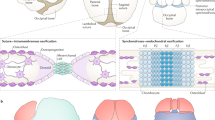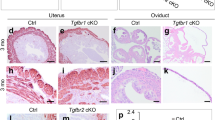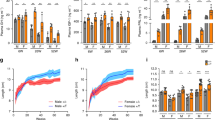Abstract
ACTIVINS are believed to initiate a signal transduction cascade by binding to serine/threonine kinase receptors types I and II1–3. Activins4 bind to several different receptors in vitro1–3, but the significance of this interaction in vivo has not been confirmed. To test the function of the type II activin receptor (ActRcII) in mammalian development and reproduction, we generated a null mutation in the ActRcII gene in mice using embryonic stem cell technology. We expected ActRcII-deficient mice to phenocopy activin-deficient mice. A few ActRcII-deficient mice had skeletal and facial abnormalities reminiscent of the Pierre–Robin syndrome in humans5,6, but most lacked these defects and developed into adults; their follicle-stimulating hormone was suppressed, and their reproductive performance was defective. These findings confirm a role of ActRcII in activin signalling in pituitary gonadotrophs. The striking lack of overlap between phenotypes of ActRcII-deficient and activin-deficient mice suggests that the ligands that signal through ActRcII during embryonic development are not activins.
This is a preview of subscription content, access via your institution
Access options
Subscribe to this journal
Receive 51 print issues and online access
$199.00 per year
only $3.90 per issue
Buy this article
- Purchase on Springer Link
- Instant access to full article PDF
Prices may be subject to local taxes which are calculated during checkout
Similar content being viewed by others
References
Mathews, L. S. Endocr. Rev. 15, 310–325 (1994).
ten Dijke, P. et al. Science 264, 101–104 (1994).
Carcamo, J. et al. Molec. cell. Biol. 14, 3810–3821 (1994).
Vale, W., Hsueh, A., Rivier, C. & Yu, J. in Peptide Growth Factors and their Receptors II (eds Sporn, M. B. & Roberts, A. B.) 211–248 (Springer, Berlin, 1990).
Caouette-Laberge, L., Bayet, B. & Larocque, Y. Plastic Reconst. Surg. 93, 934–1042 (1994).
Clarke, L., Hepworth, W. B., Carey, J. C. & Seegmiller, R. E. Teratology 38, 565–570 (1988).
Feijen, A., Goumans, M. J. & van den Eijnden-Van Raaij, A. J. M. Development 120, 3621–3637 (1994).
Matzuk, M. M. et al. Nature 374, 354–356 (1995).
Roberts, V. J. & Barth, S. Endocrinology 134, 914–923 (1994).
Woodruff, T. K., Lyon, R. J., Hansen, S. E., Rice, G. C. & Mather, J. P. Endocrinology 127, 3196–3205 (1990).
Mather, J. P. et al. Endocrinology 127, 3206–3214 (1990).
Kaipia, A., Toppari, J., Huhtaniemi, I. & Pranko, J. Endocrinology 134, 2165–2170 (1994).
Shikone, T. et al. Molec. Endocr. 8, 983–995 (1994).
deWinter, J. P. et al. Molec. Cell Endocr. 83, R1–R8 (1992).
Feng, Z.-M., Madigan, M. B. & Chen, C.-L. C. Endocrinology 132, 2593–2600 (1993).
Cameron, V. A. et al. Endocrinology 134, 799–808 (1994).
Ritzen, E. M., Hansson, V. & French, F. S. in The Testis 2nd edn (eds Burger, H. & de Kretser, D.) 269–302 (Raven, New York; 1989).
Vassali, A. et al. Genes Dev. 8, 414–427 (1994).
Hemmati-Brivanlou, A. & Melton, D. A. Nature 359, 609–614 (1992).
Hemmati-Brivanlou, A. & Melton, D. A. Cell 77, 273–281 (1994).
Schulte-Merker, S., Smith, J. C. & Dale, L. EMBO J. 13, 3533–3541 (1994).
Matzuk, M. M. & Bradley, A. Biochem. biophys. Res. Commun. 185, 404–413 (1992).
Matzuk, M. M., Finegold, M. J., Su, J.-G. J., Hsueh, A. J. W. & Bradley, A. Nature 360, 313–319 (1992).
Mathews, L. S. & Vale, W. W. Cell 65, 973–982 (1991).
Bradley, A. in Teratocarcinomas and Embryonic Stem Cells: A Practical Approach (ed. Robinson, E. J.) 113–151 (IRL, Oxford, 1987).
Ramirez-Solis, R. et al. Analyt. Biochem. 201, 331–335 (1992).
Ramirez-Solis, R. et al. Cell 83, 279–294 (1993).
Kumar, T. R., Fairchild-Huntress, V. & Low, M. Molec. Endocr. 6, 81–90 (1992).
Author information
Authors and Affiliations
Rights and permissions
About this article
Cite this article
Matzuk, M., Kumar, T. & Bradley, A. Different phenotypes for mice deficient in either activins or activin receptor type II. Nature 374, 356–360 (1995). https://doi.org/10.1038/374356a0
Received:
Accepted:
Issue Date:
DOI: https://doi.org/10.1038/374356a0
This article is cited by
-
Endometrial receptivity and implantation require uterine BMP signaling through an ACVR2A-SMAD1/SMAD5 axis
Nature Communications (2021)
-
MicroRNA-424/503 cluster members regulate bovine granulosa cell proliferation and cell cycle progression by targeting SMAD7 gene through activin signalling pathway
Journal of Ovarian Research (2018)
-
Activin in acute pancreatitis: Potential risk-stratifying marker and novel therapeutic target
Scientific Reports (2017)
-
Activins and their related proteins in colon carcinogenesis: insights from early and advanced azoxymethane rat models of colon cancer
BMC Cancer (2016)
-
Molecular specification of germ layers in vertebrate embryos
Cellular and Molecular Life Sciences (2016)
Comments
By submitting a comment you agree to abide by our Terms and Community Guidelines. If you find something abusive or that does not comply with our terms or guidelines please flag it as inappropriate.



